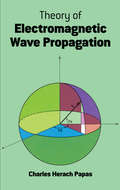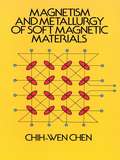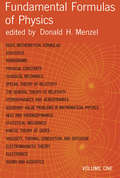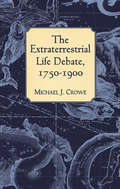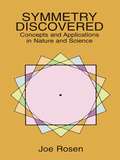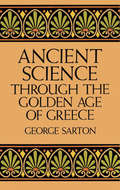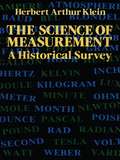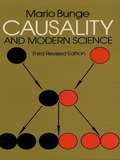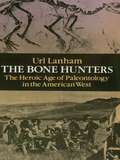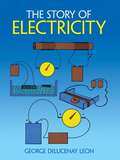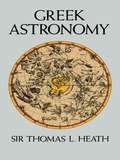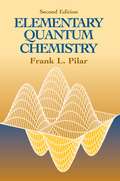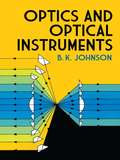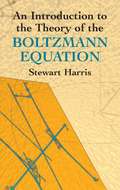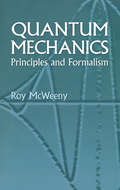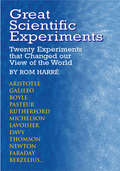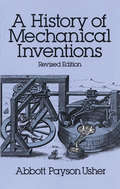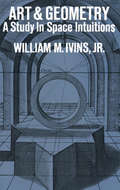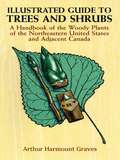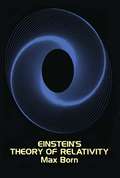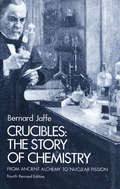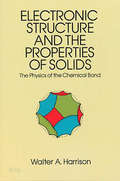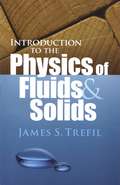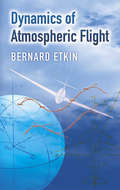- Table View
- List View
Theory of Electromagnetic Wave Propagation
by Charles Herach PapasWhile there are so many books on general electromagnetic theory for graduate-level students, there are significantly fewer that concentrate on the radiation aspects as does this well-known work. Interfacing physics and electrical engineering, Dr. Papas's clearly written text discusses highly important topics in the theory of electromagnetic wave propagation and antennas in a way that reveals the inherent simplicity of the basic ideas and their logical development from the Maxwell field equation.Chapter 1: Maxwell's field equations and those parts of electromagnetic field theory necessary for understanding the remainder of the book.Chapter 2: How the dyadic Green's function can be used to compute radiation from monochromatic sources.Chapter 3: Problems of radiation emitted by wire antennas and antenna arrays from the viewpoint of analysis and synthesis.Chapter 4: Two methods of expanding a radiation field in multiples -- one based on the Taylor expansion of the Helmholtz integrals and the other, on all expansion in spherical waves.Chapter 5: Wave aspects of radio-astronomical antenna theory.Chapter 6: Theory of electromagnetic wave propagation in a plasma medium describing the behavior of an antenna immersed in such a medium.Chapter 7: Covariance of Maxwell's equations in material media and its application to phenomena such as the Doppler effect.By unifying various topics under the single mantle of electromagnetic theory, Professor Papas has made the contents of this book easy to learn and convenient to teach. In addition, the book assembles much data previously available only in scattered research literature. The result is a superb graduate-level text that can also lend itself to self-instruction by researchers.
Magnetism and Metallurgy of Soft Magnetic Materials
by Chih-Wen ChenSoft magnetic materials are economically and technologically the most important of all magnetic materials. In particular, the development of new materials and novel applications for the computer and telecommunications industries during the past few decades has immensely broadened the scope and altered the nature of soft magnetic materials. In addition to metallic substances, nonmetallic compounds and amorphous thin films are coming increasingly important. This thorough, well-organized volume -- on of the most comprehensive treatments available -- offers a coherent, logical presentation of the physical principles underlying both the intrinsic and applied properties of soft magnetism. Two basic components are stressed: (1) traditional magnetism, which imparts magnetization and spin-dependent properties, and (2) metallurgy, which governs the preparation of the products and the attainment of their structure-sensitive properties. The book comprises seven major chapters: Introduction; Ferromagnetism and Ferrimagnetism; Magnetization and Domain Structure; Magnetic Properties; Metallurgy of Soft Magnetic Materials; Applications of Soft Magnetic Materials; and Special Topics (radiation effects and magnetic bubbles and devices). In addition to an extensive introduction to the basic principles of magnetism relevant to all magnetic materials (Chapters I-IV), Professor Chen (Lawrence Livermore National Laboratory) devotes the core of the book to a rigorous, detailed discussion of the effects of metallurgical factors such as purity, alloying, grain structure, defects, and atomic order on the properties and performance of magnetic metals, alloys, and compounds. An extensive and important chapter on the special topics of magnetic bubbles and radiation effects rounds out this timely and wide-ranging survey of a crucial topic in solid state physics. Written for materials scientists, experimental physicists, and metallurgists, the book also lends itself to use as a textbook for graduate courses in magnetic materials.
Fundamental Formulas of Physics, Volume One
by Donald H. MenzelThe republication of this book, unabridged and corrected, fills the need for a comprehensive work on fundamental formulas of mathematical physics. It ranges from simple operations to highly sophisticated ones, all presented most lucidly with terms carefully defined and formulas given completely. In addition to basic physics, pertinent areas of chemistry, astronomy, meteorology, biology, and electronics are also included.This is no mere listing of formulas, however. Mathematics is integrated into text, for the most part, so that each chapter stands as a brief summary or even short textbook of the field represented. The book, therefore, fills other needs than the primary function of reference and guide for research. The student will find it a handy review of familiar fields and an aid to gaining rapid insight into the techniques of new ones.The teacher will study it as a useful guide to a broad concept of physics. The chemist, astronomer, meteorologist, biologist, and engineer will not only derive valuable aid from their special chapters, but will understand how their specialty fits into the large scheme of physics.Vol. 1 chapter titles: Basic Mathematical Formulas, Statistics, Nomograms, Physical Constants, Classical Mechanics, Special Theory of Relativity, The General Theory of Relativity, Hydrodynamics and Aerodynamics, Boundary Value Problems in Mathematical Physics, Heat and Thermodynamics, Statistical Mechanics, Kinetic Theory of Gases: Viscosity, Thermal Conduction, and Diffusion, Electromagnetic Theory, Electronics, Sound and Acoustics.Vol. 2 chapter titles: Geometrical Optics, Physical Optics, Electron Optics, Molecular Spectra, Atomic Spectra, Quantum Mechanics, Nuclear Theory, Cosmic Rays and High-Energy Phenomena, Particle Accelerators, Solid State, Theory of Magnetism, Physical Chemistry, Basic Formulas of Astrophysics, Celestial Mechanics, Meteorology, Biophysics.
The Extraterrestrial Life Debate, 1750-1900
by Michael J. Crowe"There isn't an uninteresting page in it. It is a masterly review of an intriguing subject, erudite and entertaining, clear and all-encompassing reading for anyone interested in 'one of the most wondrous and noble questions in nature' - does extraterrestrial life exist?" - New Scientist.Are we alone in the universe? Are there other beings on other worlds who gaze into the night sky and try to imagine us, as we try to imagine them? Those questions have been debated since antiquity, but it was during the Enlightenment that they particularly began to engage the interest of prominent scientists and thinkers. In this fascinating volume, Professor Michael Crowe offers the first in-depth study in English of the international debate that developed between 1750 and 1900 concerning the existence of extraterrestrial life, a problem that engaged an extraordinary variety of Western thinkers across the spectrum of intellectual endeavor. Astronomers such as Herschel, Bode, Lalande, and Flammarion all weighed in, along with French philosophers Rousseau and Voltaire, American patriot Thomas Paine, Scots churchman Thomas Chalmers, and a host of others. Professor Crowe gives them all their say, as they address the question as a point of science, as a problem of philosophy, as well as a religious issue. The book ends with the "discovery" by Schiaparelli of the canals of Mars, the expansion of the canal theory by the American astronomer Percival Lowell, and the culmination of the canal controversy with the demonstration of its illusory nature."Crowe's book is lucid and rich in historical detail. His analysis is so fascinating and his comments on the contemporary debate so pertinent that The Extraterrestrial Life Debate can be recommended for the thoughtful reader without reservation. While a model of scholarly analysis, it has the unusual virtue of reading with the excitement of high adventure." - Sky & Telescope.
Symmetry Discovered: Concepts and Applications in Nature and Science
by Joe RosenSymmetry provides an insight into the way nature works and is often used by scientists and technologists to help solve problems. Symmetry has numerous other applications as well -- with more being discovered all the time in science, the arts and other fields of human endeavor.This classic work provides an excellent introduction to the basic concepts and terminology (including, optionally, group theory), as well as lucid discussions of geometric symmetry, other symmetries and appropriate symmetry, symmetry in nature, uses of symmetry in science and much more.Readers wishing to pursue specific topics will find many references that reflect the author's wide reading in the subject and his own obvious enthusiasm. For this edition, Dr. Rosen has provided a new preface, solutions to the problems, and an addendum to the bibliography.
The Scientific Renaissance 1450-1630
by Marie Boas HallWhile scientific inquiry has its roots in both Far Eastern and Indo-European cultures, the revolutionary ideas that made modern scientific achievements possible occurred initially in Europe. This stimulating, illuminating, and thoughtfully presented work explores the early stages of this scientific revolution, beginning with the rediscovery of Greek ideas in the mid-15th century and culminating with Galileo's brilliant Dialogue on the Two Chief Systems of the World in 1630. Noted historian of science Marie Boas Hall first gives a general account of scientific thought in the mid-1400s, then examines the Copernican revolution and the anatomical work of Vesalius and his contemporaries, the impact of chemical medicine and the efforts of the Swiss physician and alchemist Paracelsus. Also here are insightful discussions of Harvey's discovery of the circulatory system, the work of Kepler, the effects of Galileo's telescopic discoveries, and other topics. A series of accompanying illustrations -- among them a Ptolemaic map, examples of Renaissance engineering, and portraits of Francis Bacon, Tycho Brahe, Vesalius, Kepler, and Galileo -- enhance this scholarly and informative work. A valuable reference book for students of the history of science, The Scientific Renaissance 1450-1630 is "good, sound, academic stuff . . . interesting even to those for whom it is not required reading." -- New Statesman.
Ancient Science Through the Golden Age of Greece
by George Sarton"There are few scholars or scientists today who write as beautifully or as interestingly as [Sarton] . . . [his] book is magnificent." -- Ashley Montagu, Saturday ReviewAlthough science did not begin in ancient Greece (millennia of work in Egypt, Mesopotamia, and other regions preceded Greek efforts) it is nevertheless true that methodic, rational investigation of the natural universe originated largely with early Hellenic thinkers. Thus, the major part of this book is of necessity devoted to Greece. Drawing wherever possible on original sources, Dr. Sarton, one of the world's foremost historians of science, paints a vivid and illuminating picture of mathematics, astronomy, physics, biology, medicine, and other sciences as they emerged from the mists of prehistory and ultimately flourished within the context of Greek society. The book is divided into three parts. Part One begins with the earliest evidence of prehistoric mathematics, astronomy, and other science. Dr. Sarton then describes the achievements of Egypt and Mesopotamia, the dawn of Greek culture and the remarkable flowering of Ionian science in the sixth century B.C. Thales of Miletos, Anaximandrox, and Xenophanes are among the important figures discussed. An entire chapter focuses on the influential doctrines of Pythagoras.Part Two opens with the glory of Athens in the fifth century B.C. and its magnificent achievements in poetry and the arts, philosophy, and science. Described in lucid detail are groundbreaking contributions of Heracleitos, Anaxagoras, Protagoras, Zenon of Elea, Parmenides, Democritos, and many others. Also included in this section are perceptive discussions of geographers and historians of the fifth century (Herodotos, Thucydides, and others) and Greek medicine of the fifth century (chiefly Hippocratic). Part Three focuses on the extraordinary Greek thinkers of the fourth century B.C.: Plato and the Academy, Aristotle, Xenophon and many others, including such important schools of thought as the cynics, stoics, skeptics, and epicureans. Major attention is given to mathematics, astronomy and physics, natural sciences and medicine, Aristotelian humanities, and historiography and other topics. "Of great value to the general historian and an exciting, arresting story for the lay reader. -- The Yale Review
The Science of Measurement: A Historical Survey
by Herbert Arthur Klein"Klein is both a skilled reporter and a wide-ranging humanistic scholar. The book is popular and learned, witty and serious, literary and mathematical -- always solid and entertaining." -- Los Angeles Times.Although the topic of measurement might seem to lend itself to a dry-as-dust treatment, this book is just the opposite: an engrossing, easy-to-read study that treats a multifaceted topic with wit, imagination, and wide-ranging scholarship.Metrology, the science of measurement, usually concerns itself with length, weight, volume, temperature, and time, but in this comprehensive work the topic also encompasses nuclear radiation, thermal power, light, pressure, sound, and many other areas. Representing nearly ten years of research effort, The Science of Measurement is considered a definitive book on the concepts and units by which we measure everything in our universe. Nontechnical in its approach, it is not only completely accessible to the general reader but as entertaining and fun to read as it is informative and comprehensive. " . . . not concerned only with problems of measuring the limits of space or the size of the proton. It is filled with interesting digressions. Not a book for daydreaming, but a book for the curious. Klein's survey of the units and concepts by which we measure everything in the universe helps us understand that universe much better." -- Boston Herald Advertiser
Causality and Modern Science: Third Revised Edition
by Mario Bunge"I regard it as a truly seminal work in this field." -- Professor William A. Wallace, author of Causality and Scientific ExplanationThis third edition of a distinguished book on the subject of causality is clear evidence that this principle continues to be an important area of philosophic enquiry.Non-technical and clearly written, this book focuses on the ontological problem of causality, with specific emphasis on the place of the causal principle in modern science. The author first defines the terminology employed and describes various formulations on the causal principle. He then examines the two primary critiques of causality, the empiricist and the romantic, as a prelude to the detailed explanation of the actual assertions of causal determination. Finally, Dr. Bunge analyzes the function of the causal principle in science, touching on such subjects as scientific law, scientific explanation, and scientific prediction. Included, also, is an appendix that offers specific replies to questions and criticisms raised upon the publication of the first edition.Now professor of philosophy and head of the Foundation and Philosophy of Science Unit at McGill University in Montreal, Dr. Mario Bunge has formerly been a full professor of theoretical physics. His observations on causality are of great interest to both scientists and humanists, as well as the general scientific and philosophic reader.
The Bone Hunters: The Heroic Age of Paleontology in the American West
by Url Lanham"Highly recommended to all scientists and non-scientists interested in paleontology and the West." -- Science Books A century after the founding of the Republic, the United States was a leader in the science of vertebrate paleontology -- the study of the fossils of backboned animals. In this lucid, nontechnical study, a noted popularizer of science and former curator at the Museum of the University of Colorado first reviews the geology of the western United States and provides an overview of American paleontology since the days of Thomas Jefferson.Dr. Lanham next focuses on the paleontologists themselves and the astounding fossil discoveries that revolutionized our understanding of vertebrate evolution. You'll learn how nineteenth-century paleontologists struggled against hostile Indians, scorching summers and frigid winters, loneliness, isolation, lack of funds and other hardships as they excavated tons of fossil bones from beds and quarries in South Dakota, Kansas, Wyoming, Utah, Colorado, and other areas. While many eminent scientists are profiled, including Samuel Williston, John Bell Hatcher, Ferdinand Vandiveer Hayden, and Joseph Leidy, much of the book is devoted to the explorations and achievements of Othniel Charles Marsh and Edward Drinker Cope. These two brilliant paleontologists, whose discoveries revolutionized the discipline, eventually became bitter rivals and the central figures in one of the most notorious scientific feuds of the century.These and many other aspects of nineteenth-century paleontology are covered in this fascinating and readable book. Easily accessible to the layman, The Bone Hunters will appeal to any reader interested in the behind-the-scenes drama and inspired scientific fieldwork that resulted in an explosion of knowledge about the nature and evolution of the prehistoric animals that once roamed the American West.
The Story of Electricity: With 20 Easy-to-Perform Experiments
by George De LeonEasy-to-follow instructions for performing 20 famous experiments that led to major discoveries in electricity and magnetism over the past 2,500 years. Safe, clearly illustrated projects involve compasses, batteries, electromagnets, thermocouples, generators, more. List of inexpensive, readily available materials. Grades 4-6.
Greek Astronomy
by Thomas HeathAstronomy as a science began with the Ionian philosophers, with whom Greek philosophy and mathematics also began. While the Egyptians and Babylonians had accomplished much of astronomical worth, it remained for the unrivalled speculative genius of the Greeks, in particular, their mathematical genius, to lay the foundations of the true science of astronomy. In this classic study, a noted scholar discusses in lucid detail the specific advances made by the Greeks, many of whose ideas anticipated the discoveries of modern astronomy.Pythagoras, born at Samos about 572 B.C., was probably the first to hold that the earth is spherical in shape, while his later followers anticipated Copernicus with the then-startling hypothesis that the earth was not the center of the universe but a planet like the others. Heraclides of Pontus (c. 388-315 B.C.), a pupil of Plato, declared that the apparent daily rotation of the heavenly bodies is due, not to a rotation of the heavenly sphere about an axis through the center of the earth, but to the rotation of the earth itself around its own axis. Secondly, Heraclides discovered that Venus and Mercury revolve around the sun like satellites. Perhaps the greatest astronomer of antiquity was Hipparchus, who flourished between 161 and 126 B.C. He compiled a catalog of fixed stars to the number 850 or more, made great improvements in the instruments used for astronomical observations, and discovered the precession of the equinoxes, among other accomplishments. The astronomy of Hipparchus takes its definitive form in the Syntaxis (commonly called the Almagest) of Ptolemy, written about A.D. 150, which held the field until the time of Copernicus.The extraordinary achievements of these and many more Greek theorists are given full coverage in this erudite account, which blends exceptional clarity with a readable style to produce a work that is not only indispensable for astronomers and historians of science but easily accessible to science-minded lay readers.
Elementary Quantum Chemistry, Second Edition (Dover Books on Chemistry)
by Frank L. PilarAs the author notes in the Preface to this valuable text, experimental chemists have moved past studying the average behavior of atoms or molecules "to probe the step-by-step behavior of individual atoms and molecules as they collide, form 'transition states,' and ultimately form products." In such experiments, quantum mechanical computations do two useful tasks: They fill in the observational gaps and help to interpret what has been observed.This introductory course -- developed by the former chairman of the chemistry department at the University of New Hampshire -- covers, among other topics, the origins of the quantum theory, the Schrödinger wave equation, the quantum mechanics of simple systems, the rigid rotator, the hydrogen atom, electron spin and many-electron systems, the quantum states of atoms, the Hartree-Fock self-consistent field method, the electronic structure of molecules, and semi-empirical molecular orbital methods. One of the great values of the course is its calculations and diagrams, which were created specifically for this text and which students will be able to replicate on their home computers.The text will be most useful for advanced undergraduate or beginning graduate students who have had calculus and at least a year of undergraduate physics. A knowledge of differential equations, linear algebra, and atomic physics is helpful but not essential. Seven appendices give a concise exposition of mathematical and physical material that may not be part of the students' background.
Optics and Optical Instruments: An Introduction
by B. K. JohnsonThis book illustrates basic practical applications of optical principle. Working models of telescopes, microscopes, photographic lenses, and optical projection systems are diagrammed and explained in full, as are the basic experiments for determining accuracy, power, angular field of view, amount of aberration, and all other necessary facts about the instrument. Throughout the book, only elementary mathematics is used, for the benefit of the student and the beginner in the field of optics.The author, an assistant professor at the Imperial College of Science and Technology in London, shows how to set up working models of each of the four types of instruments named above, so that the reader can see for himself the effects of changing the focal length, using different types of lenses, rotating the lens, and other experiments. He also includes a number of experiments to illustrate theoretical principles such as the reflection and refraction of light and focal length measurements of concave and convex lenses.A chapter on the human eye follows, and the author explains how to set up a simple working model of the eye in order to illustrate myopia, astigmatism, hypermetropia, and the visual acuity of the eye. Professor Johnson concludes with an important chapter on the working and testing of optical glass, in which he describes the roughing of lenses, the principles of the grinding and polishing processes, abrasives, edging, angle measurement, and other important steps in the production of optical glass. An appendix is included on the cleaning of glass surfaces, silvering, photographic items, developers, collodion films, and waxes and cements used for various purposes in optical work.This is a valuable work for the student and the amateur hobbyist as well as for many who use optical instruments in science and industry. It is written clearly and economically, with the needs of the practical worker in the field of optics held constantly in mind.
An Introduction to the Theory of the Boltzmann Equation (Dover Books On Physics Series)
by Stewart HarrisBoltzmann's equation (or Boltzmann-like equations) appears extensively in such disparate fields as laser scattering, solid-state physics, nuclear transport, and beyond the conventional boundaries of physics and engineering, in the fields of cellular proliferation and automobile traffic flow. This introductory graduate-level course for students of physics and engineering offers detailed presentations of the basic modern theory of Boltzmann’s equation, including representative applications using both Boltzmann’s equation and the model Boltzmann equations developed within the text. It emphasizes physical aspects of the theory, and it represents a practical resource for researchers and other professionals. The problems following each chapter are intended as learning examples, and they frequently extend and generalize the text material. Additional editorial features include a historical introduction, references, and subject and author indexes. 1971 edition.
Quantum Mechanics: Principles and Formalism
by Roy McweenyConcerned strictly with the principles and formalism of quantum mechanics, this graduate student-oriented volume develops the subject as a fundamental discipline. Opening chapters review the origins of Schrödinger's equations and the nature of the solutions in certain simple and well-known cases, advancing to the ideas associated with vector spaces. Having provided students with the appropriate mathematical language, the author proceeds to the formulation of the main principles of quantum mechanics and their immediate consequences. The book concludes with final generalizations in which alternative "languages" or representations are discussed -- each with reference to its specific advantages and applications -- and the Dirac transformation theory is developed and explained.
Great Scientific Experiments: Twenty Experiments that Changed our View of the World
by Rom HarreThese vividly recounted tales of human skill and ingenuity offer fascinating views of the correlation between theories, practical inquiries, ideas, and facts. Re-created strictly on the basis of the original publication in which the results were first announced, the scrupulously accurate retellings of 20 groundbreaking scientific experiments are complemented with rare photos and illustrations.Based on such criteria as fame, historical importance, elegance, and economy of method, the experiments include Aristotle's work on the embryology of the chick, Galileo's discovery of the law of descent, Newton's experiment on the nature of colors, Lavoisier's proof of the oxygen hypothesis, William Beaumont's work on the process of digestion, Faraday's demonstration of the identity of all forms of electricity, J. J. Thompson's discovery of the electron, Michelson and Morely's demonstration of the impossibility of detecting the motion of the earth, and a dozen others.Each experiment is appraised and analyzed in the light of subsequent developments, placing the work within the context of the history of science. In addition to diagrams and photographs of the experimental method and apparatus, brief biographies and portraits of the scientist appear as well.Rom Harré is a Fellow Emeritus of Linacre College, Oxford, and an Adjunct Professor at Georgetown University and American University, Washington, D.C.
A History of Mechanical Inventions: Revised Edition
by Abbott Payson Usher"The book is without peer in its field." -- American ScientistIn this completely revised and enlarged edition of a classic work in the history of technology, a noted scholar explores the importance of technological innovation in the cultural and economic history of the West.Following an introductory discussion of the place of technology in economic history, the author offers a penetrating historical analysis of social change. Within this context he develops a theory of invention based on Gestalt psychology and a concept of social evolution as continuous development from antiquity to the present. Emphasis is placed on the role of economic forces in the development of technology, with scientific concepts also playing an important role in bringing about change.The latter part of the book focuses on the production and control of power in general, and in particular on a number of important operative mechanisms. Thus we read thought-provoking accounts of the technology of textile manufacture from primitive times, of water wheels and windmills, water clocks, and mechanical clocks, and the work of Leonardo da Vinci. The development of printing is carefully studied, not only for its intrinsic interest, but because of its importance for the history of science. Other topics include the production and application of power (1500-1830), machine tools and quantity production, the production and distribution of power since 1832, and the role of Asia Minor as a source of techniques which dominated the Middle Ages and the modern period as well.Thoroughly researched and cogently reasoned, A History of Mechanical Inventions belongs in the library of anyone interested in the history of science and invention, as well as the relationship of technology to economic and social history."Throughout the book there is constant proof of the author's wide learning and varied intellectual interests." -- The New York Times
Art and Geometry: A Study in Space Intuitions
by William M. IvinsOne of Western civilization's jealously guarded myths is that of Greek cultural supremacy. In this controversial study, William Ivins shows that the limitations of the Greek worldview actually hampered the development of the arts and sciences and gives a stimulating history of the new ideas of the Renaissance, especially in painting and geometry, that freed us from ancient misconceptions. Beginning with the Greeks, the author explains for the general reader the differences between ancient and Renaissance painting and sculpture, proving that the curiously static quality of Greek art arose from a misunderstanding of the laws of perspective. He then shows how this misunderstanding was corrected by Alberti, Pelerin, Durer, and other Renaissance artists who provided the first fruitful investigations of perspective. From there to projective geometry was but a step, and the author covers this major advance in our knowledge through the work of Nicholas of Cusa, Kepler, and Desargues. This book is perhaps the only concise history in English of the development of mathematical perspective and projective geometry. But the author's ability to relate styles in art to advances in geometry and his ingenious theory of the modern "visual" worldview and the Greek "tactile" worldview mean that his book will be provocative not only to mathematical historians but also to art historians and to anyone concerned with the history of thought, from philosopher to layman.
Illustrated Guide to Trees and Shrubs: A Handbook of the Woody Plants of the Northeastern United States and Adjacent Canada/Revised Edition
by Arthur Harmount GravesAuthoritative, easily accessible guide omits lengthy technical descriptions in favor of easy-to-use keys covering such characteristics as leaves, twigs, bark, buds, seeds, stems, fruit or fruit stalks, and other identifying traits. Over 300 pen-and-ink drawings by Maud H. Purdy, noted botanical illustrator. "I recommend this book most highly." -- Farida A. Wiley, American Museum of Natural History.
Einstein's Theory of Relativity
by Max BornA book in which one great mind explains the work of another great mind in terms comprehensible to the layman is a significant achievement. This is such a book. Max Born is a Nobel Laureate (1955) and one of the world's great physicists: in this book he analyzes and interprets the theory of Einsteinian relativity. The result is undoubtedly the most lucid and insightful of all the books that have been written to explain the revolutionary theory that marked the end of the classical and the beginning of the modern era of physics.The author follows a quasi-historical method of presentation. The book begins with a review of the classical physics, covering such topics as origins of space and time measurements, geometric axioms, Ptolemaic and Copernican astronomy, concepts of equilibrium and force, laws of motion, inertia, mass, momentum and energy, Newtonian world system (absolute space and absolute time, gravitation, celestial mechanics, centrifugal forces, and absolute space), laws of optics (the corpuscular and undulatory theories, speed of light, wave theory, Doppler effect, convection of light by matter), electrodynamics (including magnetic induction, electromagnetic theory of light, electromagnetic ether, electromagnetic laws of moving bodies, electromagnetic mass, and the contraction hypothesis). Born then takes up his exposition of Einstein's special and general theories of relativity, discussing the concept of simultaneity, kinematics, Einstein's mechanics and dynamics, relativity of arbitrary motions, the principle of equivalence, the geometry of curved surfaces, and the space-time continuum, among other topics. Born then points out some predictions of the theory of relativity and its implications for cosmology, and indicates what is being sought in the unified field theory.This account steers a middle course between vague popularizations and complex scientific presentations. This is a careful discussion of principles stated in thoroughly acceptable scientific form, yet in a manner that makes it possible for the reader who has no scientific training to understand it. Only high school algebra has been used in explaining the nature of classical physics and relativity, and simple experiments and diagrams are used to illustrate each step. The layman and the beginning student in physics will find this an immensely valuable and usable introduction to relativity. This Dover 1962 edition was greatly revised and enlarged by Dr. Born.
Crucibles: The Story of Chemistry from Ancient Alchemy to Nuclear Fission
by Bernard JaffeThis book is a classic in the field of popular science. Standard reading since the 1930s, it is one of the few historeis of chemistry to concentrate on the lives of the great chemists. Through these dramatic and human stories, it gives an authoritative and entertaining account of the great discoveries and advances in this scientific field. After many printings in three previous editions, this book has been newly revised by the author for this fourth edition. Beginning with Trevisan and his lifelong search for the "philosopher's stone," the author narrates the lives and discoveries of such towering figures as Paracelsus and his chemical treatment of disease; Priestley looking for phlogiston and finding oxygen and carbon dioxide, Lavoisier creating a new language of chemistry; Dalton and his Atomic Theory; Avogadro and the idea of molecules, Mendeleeff arranging the table of elements under his Periodic Law; the Curies isolating radium; Thomson discovering the electron; Moseley and his Law of Atomic Numbers; Lawrence and the construction of the cyclotron; and more. Probably the most dramatic chapter in the book, the account of the development of nuclear fission, ends the story of chemistry at its most monumental achievement. A final chapter discusses some of the consequences of nuclear fission, the discovery of nuclear fusion, and the recent work with subatomic particles. Bernard Jaffe is the author of many other science books and several science textbooks. Upon the original publication of this book, Mr. Jaffe received the Francis Bacon Award for the Humanizing of Knowledge. The American Chemical Society's History of Chemistry Division honored him in 1973 with its Dexter Award for "distinguished achievement in the history of chemistry."
Electronic Structure and the Properties of Solids: The Physics of the Chemical Bond
by Walter A. Harrison"Should be widely read by practicing physicists, chemists and materials scientists." -- Philosophical MagazineIn this comprehensive and innovative text, Professor Harrison (Stanford University) offers a basic understanding of the electronic structure of covalent and ionic solids, simple metals, transition metals, and their compounds. The book illuminates the relationships of the electronic structures of these materials and shows how to calculate dielectric, conducting, and bonding properties for each. Also described are various methods of approximating electronic structure, providing insight and even quantitative results from the comparisons. Dr. Harrison has also included an especially helpful "Solid State Table of the Elements" that provides all the parameters needed to estimate almost any property of any solid, with a hand-held calculator, using the techniques developed in the book.Designed for graduate or advanced undergraduate students who have completed an undergraduate course in quantum mechanics or atomic and modern physics, the text treats the relation between structure and properties comprehensively for all solids rather than for small classes of solids. This makes it an indispensable reference for all who make use of approximative methods for electronic-structure engineering, semiconductor development and materials science.The problems at the ends of the chapters are an important aspect of the book. They clearly show that the calculations for systems and properties of genuine and current interest are actually quite elementary. Prefaces. Problems. Tables. Appendixes. Solid State Table of the Elements. Bibliography. Author and Subject Indexes."Will doubtless exert a lasting influence on the solid-state physics literature." -- Physics Today
Introduction to the Physics of Fluids and Solids
by James S. TrefilWritten by a well-known science author, this introductory text explores the physics of solids and the field of hydrodynamics. It focuses on modern applications, rather than mathematical formalism, with particular emphasis on geophysics, astrophysics, and medical physics. Suitable for a one-semester course, it is geared toward advanced undergraduate physics students and graduate science students. It also serves as a helpful reference for professional astronomers, chemists, and engineers. Geophysical topics include the circulation of the atmosphere, vibrations of the earth, and underground nuclear tests. Subjects related to medicine include the urinary system and blood flow, and miscellaneous topics of interest include tides, Saturn's rings, the rotation of the galaxy, and nuclear fission. Each chapter offers many vivid examples of current interest, along with 10 to 15 problems that amplify the text and apply its teachings to new situations.
Dynamics of Atmospheric Flight (Dover Books on Aeronautical Engineering)
by Bernard EtkinGeared toward upper-level undergrads, graduate students, and practicing engineers, this comprehensive treatment of the dynamics of atmospheric flight focuses especially on the stability and control of airplanes. An extensive set of numerical examples covers STOL airplanes, subsonic jet transports, hypersonic flight, stability augmentation, and wind and density gradients.The equations of motion receive a very full treatment, including the effects of the curvature and rotation of the Earth and distortional motion. Complete chapters are given to human pilots and handling qualities and to flight in turbulence, with numerical examples for a jet transport. Small-perturbation equations for longitudinal and lateral motion appear in convenient matrix forms, both in time-domain and Laplace transforms, dimensional and nondimensional.
